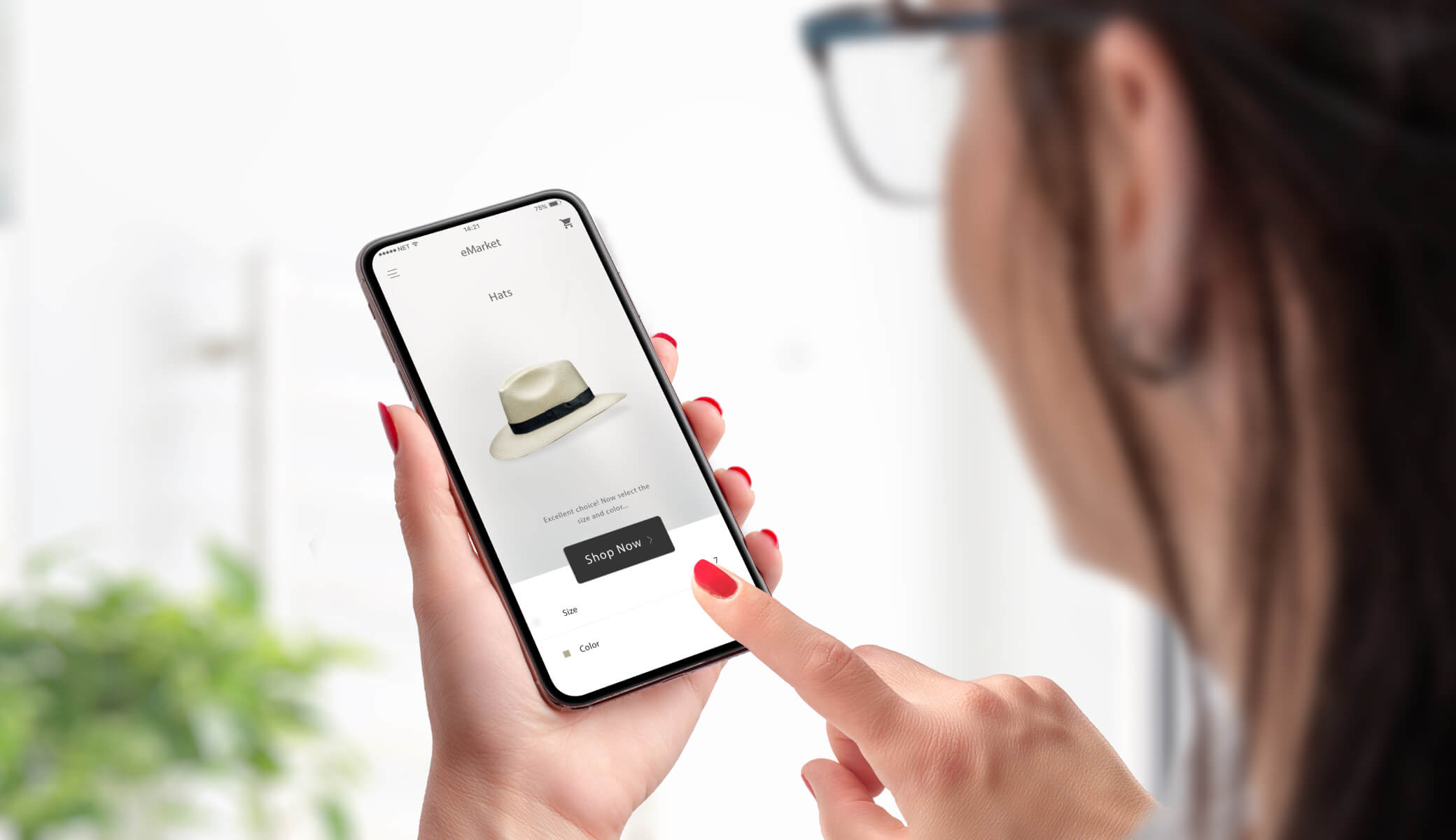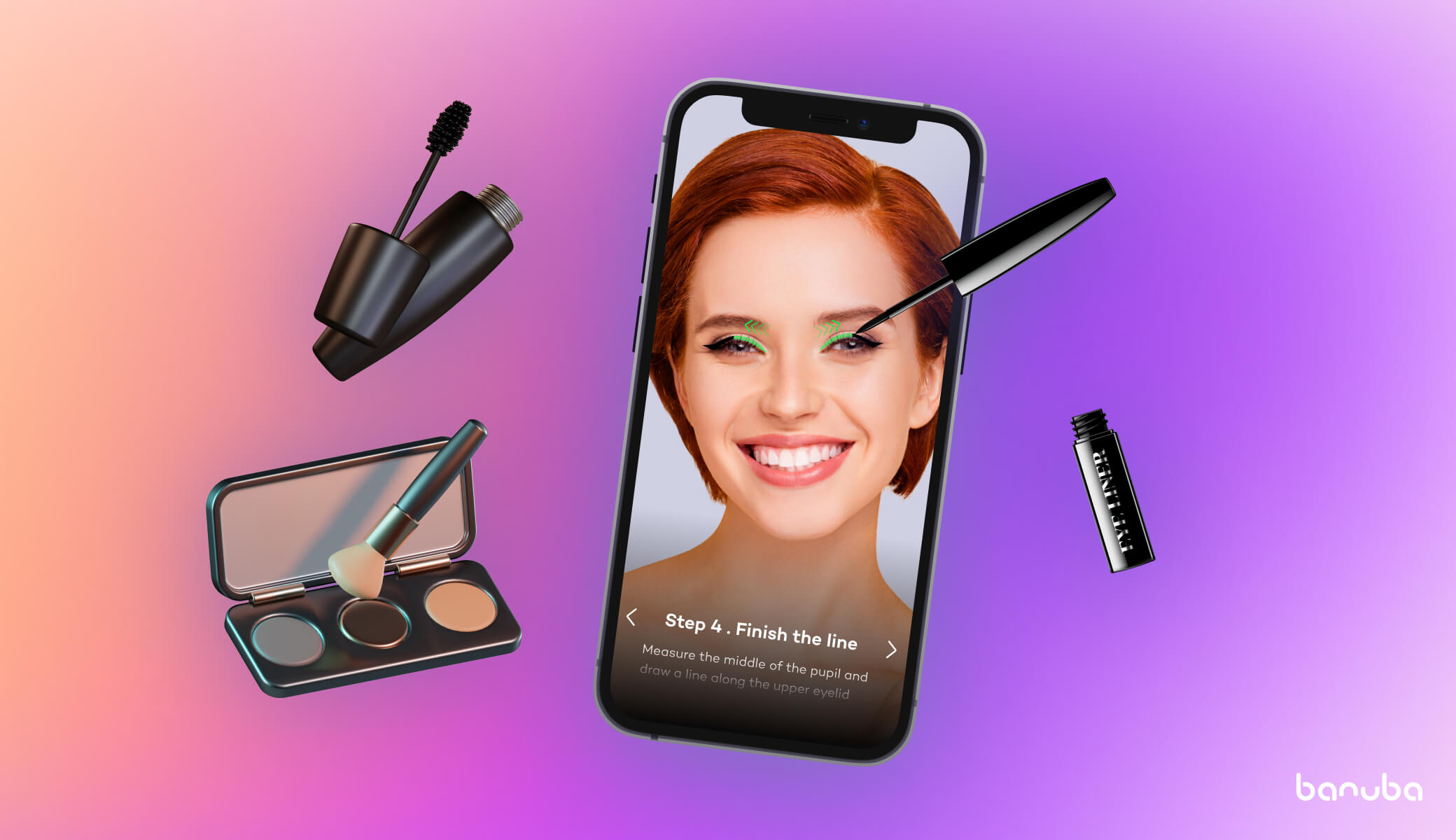Full Guide to AR in eCommerce
By 2025, almost all smartphone users, or as much as 75% of the world's population, will indulge in augmented reality (AR) experiences regularly. The introduction of AR into eCommerce can be compared to the revolutionary emergence of online shopping at the end of the 20th century — the initial distrust turned into a routine that users can't imagine their lives without.
It's time to hop on the last car of the augmented reality train and reduce returns by 60% and increase conversions by 300%. How? Let's find out.


[navigation]
How Does AR Technology Work?
AR technology overlaps digital content in the real world, enhancing our perception of reality through devices like smartphones or AR glasses.
Picture yourself browsing through makeup products on a beauty retailer's website or using their mobile app. You come across a lipstick shade that catches your eye, but you're not sure how it will look on your skin. This is where augmented reality comes in:
- Detection and Recognition: When you select the lipstick shade for virtual try-on, the AR technology in the app uses your smartphone's camera to detect and recognize your facial features, including your lips.
- Overlaying Digital Content: Once your facial features are recognized, the app overlays a digital representation of the lipstick onto your lips in real time. This creates the illusion that you're wearing the product, even though it's just a digital projection.
- Interaction: With the virtual lipstick applied, you can move your face around, smile, or pout to see how the shade looks from different angles. The AR technology accurately tracks your facial movements to ensure a realistic and immersive experience.
- Visualization and Decision Making: By seeing the lipstick shade on your own face through the virtual try-on feature, you can get a better sense of how it complements your skin tone, facial features, and overall look. This visualization helps you make a more informed decision about whether to purchase the product.
Augmented Reality technology helps to bridge the gap between online browsing and in-person interaction. According to the Snapchat report, nearly 95% of Gen Z representatives would love to stick to the AR experience in online shopping.
Virtual Reality vs. Augmented Reality — What's the Difference?
The concepts of virtual reality and augmented reality are usually associated with each other as if they were pieces of a puzzle that are destined to be together. However, these two notions are quite distinct.
Virtual reality creates immersive digital environments that entirely replace the user's physical surroundings. It requires special wearable equipment (VR headset) to immerse a user into a desired experience and setting. Consumers can interact with and navigate through VR environments, often using handheld controllers or motion-tracking systems.
The complexity of using special glasses significantly narrows the target audience with which retailers could build interaction. However, with the release of Apple Vision Pro, we are convinced that this technology will soon become commonplace and bring eCommerce to the next level in the Metaverse.
On the other hand, Augmented Reality overlays virtual elements onto the user's real-world environment, enhancing their perception of reality rather than replacing it entirely. AR experiences can be delivered through various devices, including smartphones, tablets, smart glasses, and headsets with transparent displays. With 4.8 billion people owning those, augmented reality in eCommerce becomes a more available source of additional interaction.
Types of AR Applications
Depending on the AR technology usage, there are various types of AR apps that you can choose for your online retail based on your needs.
Markerless AR
Picture this: you're exploring a museum, and suddenly, historical figures come to life right before your eyes! Markerless AR doesn't rely on specific markers or codes. Instead, it uses the environment itself to overlay digital content seamlessly. Think Snapchat filters that track your face or the IKEA place app that lets you visualize furniture in your room without needing special reference points.
Marker-Based AR
This type is also known as image recognition Augmented Reality. It uses specific markers(e.g. QR codes), to trigger digital content. You scan a marker, and voila! Your phone transforms it into an interactive experience. Businesses like Starbucks have used marker-based augmented reality to engage customers. Remember their holiday cups that came to life with animations when viewed through the app? Ray-Ban's Virtual Mirror is another bright AR experience, allowing customers to find the ideal sunwear. That's the magic of markers!
Location-Based AR
Ever played Pokémon GO? That's location-based AR in action. It uses your device's GPS and compass to superimpose digital content onto the real-world environment based on your location.
Projection Based AR
Imagine having your own personal holographic display! Projection-based AR projects digital content onto real-world surfaces, creating immersive experiences without needing a screen. It's everything you have seen in sci-fi movies but in the real world. Back in 2017, NIKEiD Direct Studio in London opened an extraordinary store powered by AR experiences.
How is Augmented Reality Applied in the eCommerce Industry?
According to Shopify, the usage of AR tools can increase the conversion rate by 94%. As much as 63% of Zen G representatives believe that the AR experience can simplify the way we shop online. But how can any business bring augmented reality in eCommerce?
Virtual Try-On Solutions for AR Shopping
One of the most impactful applications of AR in eCommerce is virtual try-on experiences. By leveraging AR technology, customers can virtually try on products like clothing, accessories, and makeup using their smartphones or tablets. For example, beauty brands utilize augmented reality to allow customers to virtually try on lipstick shades or eyeshadow palettes, giving them a realistic preview of how the products will look on their skin. This feature enhances the online shopping experience, increases confidence in purchasing decisions, and reduces the likelihood of returns.
Developing a dedicated solution for each brand is a total waste of money and time. Most retailers find a reliable partner to leverage their expertise and technology. TINT virtual try-on platform is powered by AI, featuring smart product recommendations based on consumers' individual features and preferences. It allows trying on products from the beauty and fashion industries, increasing the upsale and cutting the return rates.
3D Online Shopping
AR enables the creation of virtual stores where online shoppers can browse and interact with products in a three-dimensional environment. Instead of traditional images, customers can explore virtual aisles and shelves, visually inspecting items from different angles and sizes. This immersive experience mimics the feeling of in-store shopping, increasing user engagement and leading to more informed purchasing decisions.
You might have already seen Dior do it. In collaboration with Harrods, it created the "Atelier of Dreams" back in 2021 — a virtual store with an immersive experience. But not only Dior can afford this. With the Multiproduct Virtual Store Platform from Banuba, you can turn any online store into an immersive digital boutique. It's web-based and allows easy integration onto any device with a screen and camera.
Preview Placement in the Physical World
Augmented Reality enables customers to preview how products will look and fit in their physical environment before making a purchase. For example, home decor retailers offer AR solutions that allow customers to place virtual furniture or decor items in their rooms using their smartphones or tablets. By visualizing products in context, customers can ensure they complement their existing decor and accurately gauge size and scale, leading to more satisfied purchases.
In 2023, Wayfair launched its Decorify — an AI-powered digital room styler. Just take a picture of your room, and the app will offer a transformation overlay featuring items available in stock. Similar solutions will be a win-win choice for furniture retailers and designers.
Interactive User Manuals
Augmented Reality can enhance post-purchase experiences by providing interactive guides and tutorials. Instead of traditional paper manuals, customers can use AR-enabled apps to scan products and access step-by-step instructions overlaid onto the physical item itself. This hands-on approach improves user engagement and comprehension, reducing frustration and support requests.
Companies can leverage Augmented Reality in traditional brick-and-mortar stores just like Lowe's did in 2017. They basically added the search tab and navigation powered by AR into their stores, making the customer experience more enjoyable and simpler.
Social Media Filters
AR-powered social media filters have become increasingly popular for eCommerce brands. By creating branded effects, companies can engage with customers on social media platforms like Instagram, TikTok, and Snapchat, allowing users to virtually try on products or interact with branded digital content. These filters drive brand awareness, encourage user-generated content, and foster community engagement.
Gucci, Prada, Addidas, and NYX are just a few of the frequent users of AR effects in their digital marketing. But they are manufacturers, not retailers. Sephora, on the other hand, is an international leader in the omnichannel approach. It used an AR filter for Instagram to help consumers choose their fragrance, leading to a 3.6-point increase in brand association with the aroma compared to competitors.
3D Product Construction
AR enables the creation of detailed 3D models of products, allowing customers to explore every aspect before making a purchase. For example, automotive companies utilize AR to provide interactive tours of vehicles, allowing customers to inspect interior features, customize options, and experience virtual test drives. This immersive approach enhances product understanding and increases confidence in complex purchases.
Why is AR a Perfect Match for Online Shopping?
Let's bring down all the benefits of augmented reality technology in simple words and numbers.
Enhance Customer Engagement and Customer Experience
Augmented Reality fascinates customers with interactive and immersive experiences, making the buying journey more engaging and enjoyable. According to ThreeKit, AR-powered brands and retailers are 200% more engaging than their rivals. By allowing customers to virtually try on products, visualize items in their own space, and interact with 3D models, AR enhances the overall shopping experience, leading to higher levels of customer satisfaction and loyalty. It allows increased engagement on the level with the physical store but is accessible from any location.
Boost Online Sales
By offering virtual try-on experiences and interactive product visualizations, AR increases purchase confidence and encourages impulse buying. Additionally, the novelty and excitement of AR experiences can attract new customers and differentiate brands from competitors, further boosting sales.
The AR market is expected to grow at a CAGR of more than 65%. And while 61% of consumers prefer shopping online from retailers offering AR, only 1% of the latter have already introduced the technology into their businesses.
Reduce Return Rates
One of the biggest challenges in online retail is the high rate of returns due to discrepancies between product expectations and reality. AR addresses this challenge by enabling customers to preview products in their own environment before making a purchase. By visualizing how items will look and fit, customers can make more informed purchasing decisions via better understanding, leading to fewer returns and exchanges and ultimately saving time and resources for both customers and retailers.
Enlarge the Target Audience
AR technology has the potential to attract a broader audience to online shopping by catering to diverse preferences and needs. For example, virtual try-on experiences appeal to fashion-conscious consumers who want to experiment with different styles before committing to a purchase. Similarly, interactive 3D product visualizations appeal to tech-savvy shoppers who value immersive and interactive shopping experiences. By offering a range of AR-powered features, online retailers can appeal to a wider demographic and capture new market segments.
How to Implement AR Technology Into eCommerce Businesses?
- Identify your business objectives and answer a simple question - why implement an AR experience into your online stores? Whether it's enhancing the shopping experience, increasing sales, reducing returns, or reaching a new audience, having clear objectives will guide your implementation strategy.
- Based on your needs, choose the AR technology app type that will fit your business best. Developing an AR app from scratch is a pricy pleasure that will take years. The ultimate choice will be to partner up with a tech company offering customizable off-the-shelf AR solutions. Consider factors such as ease of integration, compatibility with your eCommerce platform, available features, and customer support.
- Choose the suitable integration option. With Banuba, you can choose between Web AR SDK with a no-app and cross-platform experience or an AR Plugin integration compatible with major CMS on the market.
- Monitor and analyze user engagement and behavior data to measure the effectiveness of your AR implementation. Track metrics such as conversion rates, time spent interacting with AR content, and customer feedback to identify areas for improvement and optimization.
- Continuously iterate and improve your AR features based on user feedback, technological advancements, and changing market trends. Stay updated on new AR technologies and innovations to remain competitive and provide cutting-edge shopping experiences for your customers.
AR in eCommerce turns online shopping experiences into a fascinating adventure. While fun and engaging for users, it shapes the future of the retail industry. Don't be among the 1% — integrate AR today and be ahead of your competitors tomorrow.






